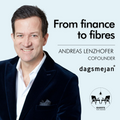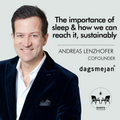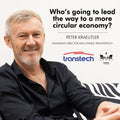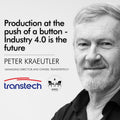Blockchain: limitless possibilities from digital wardrobes to the supply chain with Dr. Michael Gebert
Blockchain: limitless possibilities from digital wardrobes to the supply chain
GUESTS FOR CHANGE with Dr. Michael Gebert
PART 2
Within the Guests for Change series, thought leaders, pioneers, visionaries, and game-changers are interviewed to give us more insight into the world of sustainability and circularity. As humans, we are at the frontier of cutting-edge digital technologies - the 4th Industrial Revolution if you will. Things are changing and they’re changing fast. And the world of fashion is among the industries embracing this.
Technologies that enable Industry 4.0 and the digitalization of production are already revolutionizing the way things work. Fashion sits at the crossroads between the virtual, the creative and the tangible. We continue our discussion with Dr. Michael Gebert, the Chairman of the European Blockchain Association, exploring one of the newer technologies in the modern world - blockchain.

Image via Getty Images
As a system of technology, blockchain operates within the scope of being a decentralized network. This means that there is no central control point, so anyone can join the network and become part of it. One of the examples of a decentralized network, that many are already familiar with, is bitcoin - where anyone can create a wallet and become part of the network. This also means that there is no requirement or barrier to become part of it. This differs drastically from the centralized systems that we have been used to operating within. Centralized systems are created and controlled by a single entity, or entities, which have full control over the network. Current governments, for example, use centralized systems to offer their services. Businesses are no different as they utilize centralized networks to run their business.
“If you define blockchain the original way, in the pure way,” shares Dr. Gebert, “Then, by default, everything is protocol, everything is governance, everything is free to see for everybody. It’s what we call a “public permissionless” blockchain. It is an open architecture and there is practically no chance for fraud or for any misuse for a government, per definition.”
“If you define blockchain the original way, in the pure way,” shares Dr. Gebert, “Then, by default, everything is protocol, everything is governance, everything is free to see for everybody. It’s what we call a “public permissionless” blockchain. It is an open architecture and there is practically no chance for fraud or for any misuse for a government, per definition.”
Understanding the difference between centralized and decentralized systems helps to envision the difference between permissioned and permissionless blockchains. Permissioned blockchains are still decentralized systems but they allow the restriction of the use of a blockchain to a certain group - with rules and regulations that are important to this group in place. This can be especially useful when introducing the use of this form of decentralized technology into an already existing industry - such as the textile and fashion industry.

Image via Getty Images
“Normally, you have existing ecosystems within industries, like the fashion industry has its own ecosystem. It’s important to have a governance structure because every industry needs a rule-set. So if you were to build a permissioned blockchain on the ecosystem - it would be decentralized and have a governance model. You would want to be able to do private transactions, have an authentication process and you would want to authorize dealers or authorize producers, with extremely fast output. In short, you don’t want to go on a traditional “open-to-all” technology. You would also want to have a scalable network, and an energy-efficient, environmentally friendly technology. Of course, this means that it can not be purely decentralized. But it really depends on where you want to go.”
you want to go from the technical layer to a very practical layer - by looking at the processes that you already have, and assess if these processes are data-driven or not. If they are data-driven, then ask what is that data giving me on a trusted level?”
“I personally would not recommend for an industry to use a permissionless blockchain method in the beginning,” states Dr. Gebert. “You, first of all, want to learn the attributes of the system and really build the benefits and advantages for the industry partners. And you also don’t want to have long phases of testing and trial-and-error. Introducing new technologies can obviously be a little overwhelming at first. We saw this a few years ago when almost all of the blockchain projects failed because it was too technical. Rather, you want to go from the technical layer to a very practical layer - by looking at the processes that you already have, and assess if these processes are data-driven or not. If they are data-driven, then ask what is that data giving me on a trusted level?”

Image via Ikostudio
“Let’s take the example of a certificate of trust, or a certificate of proof. We need to ask if it is a trusted piece of paper? If it is, we can add a barcode on the paper, and transmit the barcode data. Then you are not interfering with an already-existing process. Instead of introducing a new, possibly overwhelming or intimidating technology, you rather upgrade the existing process with some new information on a technological level. The added information basically is a permissioned blockchain technology layer, which gives this piece of paper authenticity on a data level… I think this is the way to go when it comes to the fashion industry, or even to any other industry which has an already exsiting substantial ecosystem.”
“Let’s look at the emerging trend,” he continues, “The non-fungible tokens or NFTs. NFTs are basically tokens and they are not to be copied. They are non-fungible. They are declared unique. So these NFTs now make a very interesting transformation. First, they were introduced in the art industry and are now entering the the fashion industry."
"The first side is the physically-designed piece that you can wear and touch, and the other one is the digital ownership of the piece which you could sell."
"So let’s say you have a clothing collection. Not only do you have a unique design, you also can have it limited to 10 pieces. Or, let’s say, you have a show and you want to make sure that it is definitely that specific piece of clothing - then that piece can now be a token. Which means that you could have two sides to the piece. The first side is the physically-designed piece that you can wear and touch, and the other one is the digital ownership of the piece which you could sell. It sounds a little bit abstract, but it’s crazy what’s going on there at the moment. So basically, imagine that you’re wearing your nice brown sweater, and there is also a digital version of that sweater that you have stored on an exchange. You may have sold that sweater for a thousand dollars on the virtual exchange, but you’re still wearing it. So you have two ownership titles - which is quite interesting.”

Image via Getty Images
This idea steps further into the realms of the space between the digital and the tangible. The question then arises as to why you would want to have multiple “ownerships” over a piece - with one perhaps that you could never wear?
Dr. Gebert responds, “Imagine you have a sweater that is a piece that was made by your husband or your grandmother, or someone that you have a really deep connection with. So it means something to you personally. And imagine that this piece is lost, stolen, or you just don’t have it anymore in a physical way - but you still have it in a digital way. So the peace of mind that comes with that is interesting.”
“Imagine you have a sweater that is a piece that was made by your husband or your grandmother, or someone that you have a really deep connection with. So it means something to you personally. And imagine that this piece is lost, stolen, or you just don’t have it anymore in a physical way - but you still have it in a digital way. So the peace of mind that comes with that is interesting.”
“There is some really interesting research in regards to the psychological aspects of these two different types ownership. Imagine you have an artwork and you rent out the artwork. At the moment, the art galleries are no longer sending out the actual piece - especially when it comes to digital art - but they are sending out the digital title. And you can see the digital title and you can buy the digital title. So personally, I would do it for that reason. If I have a piece that is really important to me, I’d want to make sure that I have a digital version and I have a real version - an analog, material version. With material things, as with everything, the circle of life is that it is always used, and it can be gone tomorrow. But the digital version is here to stay.”
Furthermore, in terms of supply chains, the textile industry is one of the most fragmented on the planet at the moment. To produce a single garment is oftentimes a very complex process, with raw materials exchanging many hands across multiple countries before reaching completion and being sold to a client. Within this, blockchain can have a profound impact on the move towards being more circular. Accurate data can be tracked, measured, and real changes can be implemented with their effects measured throughout the entire chain. Everything from proving the authenticity of an item, to recording and sharing supply chain information, to communicating with customers after a sale, evaluating worker welfare and transferring the ownership of digital clothing pieces may be integrated and tracked using blockchain technology.
Everything from proving the authenticity of an item, to recording and sharing supply chain information, to communicating with customers after a sale, evaluating worker welfare and transferring the ownership of digital clothing pieces may be integrated and tracked using blockchain technology.
There are already examples of companies around the world that are integrating blockchain technology to create a permanent record of each of the stages of their production. "With blockchain it is impossible to manipulate the results," says Francois Souchet, a sustainability expert at the Ellen MacArthur Foundation, an environmental non-profit working to improve the fashion industry's environmental record. "It provides all actors across the supply chain with certainty that the information is true. Once you have transparency within your supply chain, then you can reduce your environmental impact and improve overall quality," he adds. And this type of unprecedented transparency can even allow you to track parts of your garment that you may not even have thought about before - such as what sheep provided the wool for your piece. It even extends to the point of having data on what happens to garments after having gone through their wearable lives - and where they end up, material recovery, whether their yarns are recycled, disposed of, or if the item is thrifted. Although many may question the overlap between textiles and technology, it is more and more clear that their relationship is harmonious.
this type of unprecedented transparency can even allow you to track parts of your garment that you may not even have thought about before - such as what sheep provided the wool for your piece.

Image via FOX from Pexels
In this way, shares Forbes, blockchain technology becomes a critical enabler: It helps provide an ecosystem with a trusted set of data and transactions on which the entire ecosystem can make collective decisions. In light of this, the good that can come from using blockchain is immense. Dr. Gebert even outlined how this technology has enabled the World Food Programme’s Building Blocks system. According to the WFP’s website, it has been “rolling out blockchain technology —a type of distributed ledger technology— as part of its “Building Blocks” pilot, to expand refugees’ choices in how they access and spend their cash assistance. WFP is also exploring whether Building Blocks can make cash transfers more efficient, secure and transparent. Most notably, WFP has been using blockchain to deliver food assistance more effectively to 106,000 Syrian refugees in Jordan. Building Blocks facilitates cash transfers while protecting beneficiary data, controlling financial risks, and allowing for greater collaboration.”
While the future is limitless, one thing for certain is that the benefits of blockchain have not yet reached their full potential. As this technology develops, and more and more people begin to make use of it, and create more ways to put it into use, it is apparent that it will transform many of the processes that we are currently familiar with today.








Leave a comment